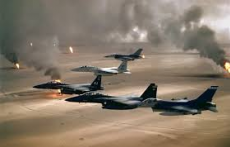
Having said this, although the development of aerial warfare was revolutionary and significant, it could not combat all terrains as effectively as conventional ground forces, which the USA discovered in the Vietnam War. The Jungle tree canopy provided a natural cover for Ho Chi Minh’s Vietminh forces on the ground and when the deforestation attempts by the US failed it was clear that bombing missions such as ‘Operation Rolling Thunder’ were not to be as successful as on the open expanse in Korea. Similarly, when the Soviets invaded Afghanistan in 1979 the Mujahedeen were able to use the multitude of caves in the mountainous regions to hide from Soviet air power, so the geography of a battlefield sometimes proved a weakness of developing air warfare despite the ability to fly. This showed that air warfare, though a significant development in the period 1845-1991, did have its limitations and land and naval involvement is also necessary in warfare.
Yet some wars in the period were won almost entirely by air power such as the ‘6 Day War’ in 1967 when Israel launched a heavy series of air strikes against Egypt, Jordan and Syria, quickly obliterating their air forces whilst they lay dormant on the ground and then swiftly claiming victory with their resulting air superiority. The introduction of fast moving jets capable of strafing bombing runs again forced a strategic change in the nature of warfare and helped avoid the repeat of such long drawn out wars of attrition as the First World War. Thus the development of aerial warfare in this period is again significant because it not only brought changes to the way wars were fought but also helped the majority of wars to reach a definitive conclusion of some form rather than a stalemate or ceasefire due to the fast and destructive nature of aerial warfare.
The development of air warfare in the period 1845-1991 was of great significance as it helped improve logistics, outmanoeuvred the majority of terrain, dramatically increased the speed of war and, perhaps most notably, usurped the navy and land forces in the majority of situations. All of these factors as well as the increasing use of technology in warfare can be seen at the very end of the period in the Gulf War 1990-91 which truly highlighted the significant development of aerial warfare since 1845. Although Saddam Hussein controlled the fourth biggest army in the world and a number of missiles, the Coalition forces (predominantly US) were able to quickly sever Iraqi communications and logistics with a succession of aerial assaults, taking the Iraqis entirely by surprise. This most modern war in the period featured innovations of war such as stealth technology (the US ‘Nighthawk’ Stealth Bomber) and GPS (Global Positioning System) which allowed for even faster movement across the battlefield and these new developments, incorporated into aircraft, allowed the West to encircle and defeat Hussein’s forces quickly and avoid becoming involved in a long guerrilla style war.
In considering the process of change in the conduct of warfare in the years 1845-1991, aerial warfare can only be argued to have been incredibly significant as it was, I would conclude, the driving force behind many new technological innovations, it dramatically increased the speed of warfare, and gave a great sense of diversity. Some new aircraft were capable of taking on very diverse multiple roles in warfare both militarily and logistically, such as the HUEY helicopter used heavily in the Vietnam war to fight, transport troops, carry supplies and even as an early air ambulance. Ultimately, the devastating potential of the fast and powerful jets produced towards the latter end of the period was unparallel to any land or naval based vehicle and the ability to carry and deploy nuclear weaponry surely portrays that the development of aerial warfare in the period 1845-1991 was of the utmost significance.
(As you can see there are many things to consider in War and history; try impressing your teachers with some of these facts about the history of aerial warfare!)

0 Comment:
Be the first one to comment on this article.